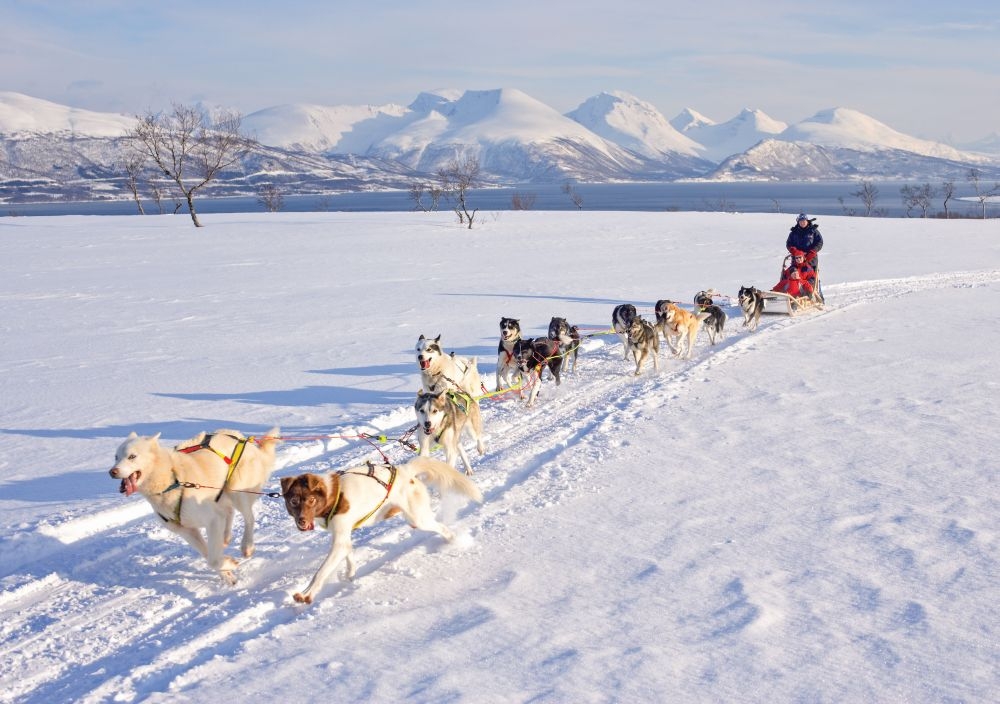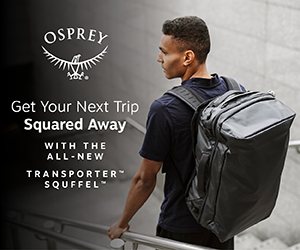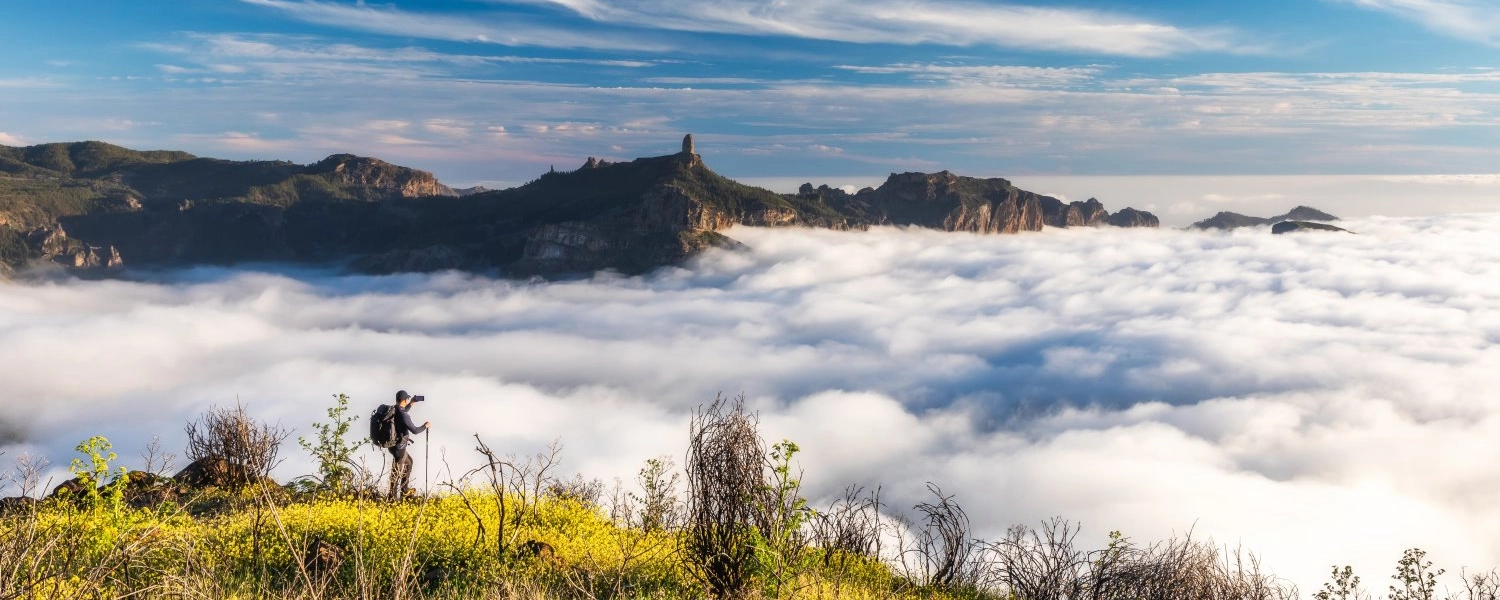- Details
- Written by: Mike Walker
As the sun sets, I look out over slopes of untouched snow rolling down into a fjord the colour of pewter, the fading light casting an orange tinge, as though the vast, metallic expanse of water is rusting around the edges.
Blanketed in fresh flakes, the slopes drop away from me, and I can't resist stamping the first footprints in its pristine surface.
I look down at my feet, and the clown-sized grey and purple snowshoes I’m wearing, acknowledging that this clunky footwear can, as I’m discovering, open up wild and beautiful winter landscapes made otherwise inaccessible by deep snow.
Up here, the solitude and stillness is almost eerie.
Yet below, within walking distance, lies the Norwegian city of Narvik, its buildings dusted white, a single ship in its port.
This high up, I make out the railway line, running like a straight scar through the landscape, stretching from Ofotfjord on the left, through mountains and into Sweden, rich in iron ore, in the distance on the right.
Along with skiers and walkers, I've taken the eight-minute Narvikfjellet cable car and climbed 656m above town to the top station, where the wind whips the snow like steam.
Kikki Westerheil, my guide around this Arctic region, hands me some poles and helps me strap the bear-clawed, beaver-tailed snowshoes over my walking boots. Thankfully, the ‘tennis-racquet’ days are long gone, replaced by today’s skateboard-sized, lightweight plastic and metal frames with crampons on the soles.
“Ready?” Kikki asks with a smile, pulling down his red peak cap and hoisting his backpack higher on his shoulders.
Clipped in and slightly bow-legged, we watch the skiers and walkers turn right on well-used tracks, before setting off in the opposite direction ourselves.
The snowshoes provide traction and stop our feet sinking, and soon I get into a rhythm, using my poles for balance.
For uphill sections, I raise a bar under the heel, levelling my feet and reducing the fatigue in my calves. Keeping my weight forward, I kick into the slope and press down to make a step, over and over.
Downhill is where things get fun. I start by digging my heels in, using the metal teeth for grip, my quads burning with each step.
Then I lean back until I slip, slip, and then fully slide down the hill. I’m whooping at the thrill of the glide until I accidentally place one massive foot onto the other and take a tumble into soft, deep snow.
Brushing myself off, we head to Kikki’s favourite viewpoint that overlooks the majestic, still waters of Ofotfjord with mountains reflected on its surface.
He points out the partially-submerged wreckage of a Nazi ship, which still bears witness to Narvik’s important role in WW11, as the place the Allies won their first battle against the German forces in 1940.
We push on downhill, weaving through trees heavy with snow. Some have silver discs hanging off their branches in the breeze, like makeshift Christmas baubles.
“Light reflectors,” Kikki explains, seeing my puzzled look. “Sometimes people come up here at night after they finish work or to see the Northern Lights if there's a good display.”
Later, a meal of lamb, potatoes and swede mash, served in Narvik Mountain Lodge, is ample reward for our snowshoeing efforts.
Time to ski
The next day I’m back on the same snowy piste – this time in daylight and on skis. Only today it’s snowing, and strong winds have forced the chair lift to close, but there are five other lifts to make the most of.
These slopes are not to be scoffed at. They hosted the downhill world cup in 1992, and there are plans to introduce a new chair lift and snow machine next year.
The peak season at this ski centre runs from February to early April, and there are 13 slopes, as well as seven miles of illuminated cross-country trails. It’s suitable for all levels, from beginner to expert, and there’s ski guiding as well as a ski school.
Heading uphill with Kikki on a T-bar, I’m surprised by how good the visibility is, despite the falling snow. It must be even more spectacular on a clear day, with views stretching out to the fjord.
Before long, I’m chasing downhill after Kiki, cutting fresh tracks and weaving through the trees, passing only a handful of other skiers and boarders.
Unlike my experience of the Alps, here the slopes are both uncrowded and ungroomed. The layer of fresh powder carpeting the runs is softer than corduroy pistes but heavier in places. It makes it the perfect training ground for off-piste novices. But it’s also hard work, and soon my thighs are burning.
There is a real local feel on the mountain, where everyone seems to know each other, and we pass a group of three women skinning uphill, who smile and say a friendly “hei”.
“That lady at the back was Anna Bågenholm,” Kikki says. “In 1999 she had a skiing accident near here and was trapped under a layer of ice for 80 minutes."
By the time she was rescued, her heart had stopped and her body temperature was the lowest ever recorded but she was brought back to life and, demonstrably, is still skiing.
True north
After a morning on skis, a relaxing four-hour bus journey took me to Tromsø – Norway’s most northerly city, popular with tourists searching for the Northern Lights.
Tromsø may be 250 miles inside the Arctic Circle, but when I arrive under dark skies, there’s a warm and friendly bustle to the place, where, clustered along the edge of an impressive fjord, the wood-clad houses are painted in falu red, mustard yellow, bottle green and Nordic blue.
Once settled in, I head to Flyt, a restaurant with candles in the windows, posters of extreme sports on the wall, and a chilled out vibe. Here you can build your own burger, picking the size of your meat, fish or veggie filling, for about 130 krone (£13). I wash mine down with lager made in the local Mack Brewery, the world’s most northerly brewery.
The refuelling is needed because the next morning I find myself in the middle of a deep-frozen landscape, at the helm of a sled pulled by a pack of over-excited huskies.
I’m mushing – driving a dog sled – at Tromsø VIllmarkssenter, a half-hour drive from the city. This is the traditional way of traversing the snowy tundra and, as I’m about to discover, being a musher is hard work.
I heard and smelled the 300 Alaskan huskies before I met them, guided by Nadia, one of the 40 members of staff here.
“Each dog has its own personality and its own name,” she says, as we weave our way through wooden huts and huskies ranging in colour from black and white to tan.
“But they are all crazy for running. When you bring the harnesses out in the morning, they bark like crazy to be picked.”
I soon see what she means – my huskies are exploding with excitement, the thrill of the chase infecting their colleagues who howl and wail with the delight of anticipation.
“There are three rules to remember,” Nadia says, as I tug my hat down against sub-zero temperatures and prepare for take-off. “Help uphill, brake downhill – and hold on!”
Then we’re off, dashing through the wintry scene with no sounds but the dogs breathing and the crunch of the skids beneath me.
Every time the sled reaches an incline, I have to take one foot off and do skateboard-style pushes to help. When we go downhill, I push on a foot brake that lets out a scraping sound but controls the speed of the sled.
All the while I counterbalance with my bodyweight – and hang on. At one point I almost slip off, and at another, the sled threatens to topple over.
I quickly lose my breath, panting with the dogs that are yelping excitedly as they run, their tongues lolling from their mouths.
The scenery we pass is a mixture of rolling white slopes, stunted forests and a brooding fjord – and all utterly empty of people.
As we pull to a stop and I say goodbye to the huskies, sunlight pierces the clouds and catches on the snow, making it sparkle like diamond dust.
Snowshoeing, skiing and dog sledding all in one trip, discovering an alien, frozen and practically unpopulated landscape? I can see a return visit on the horizon.


